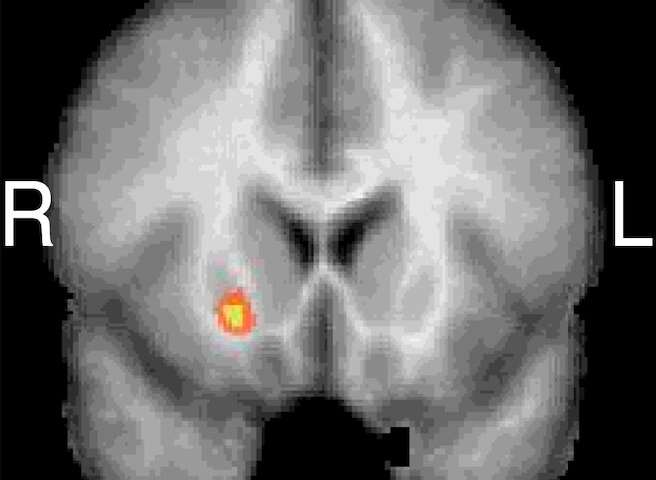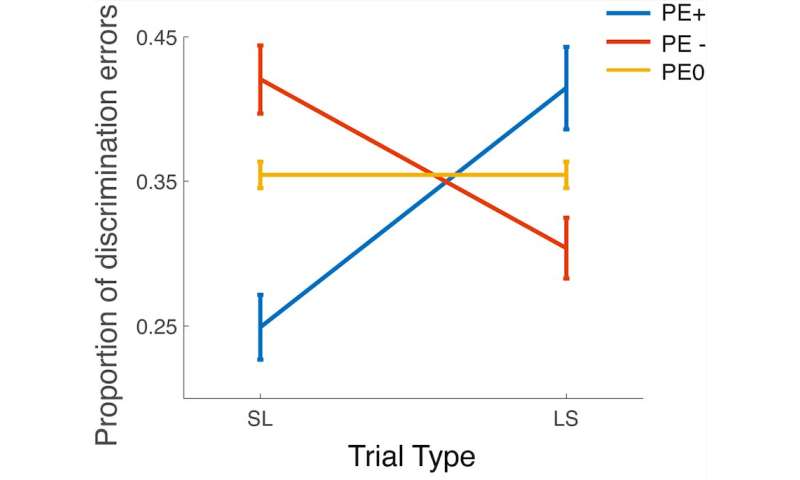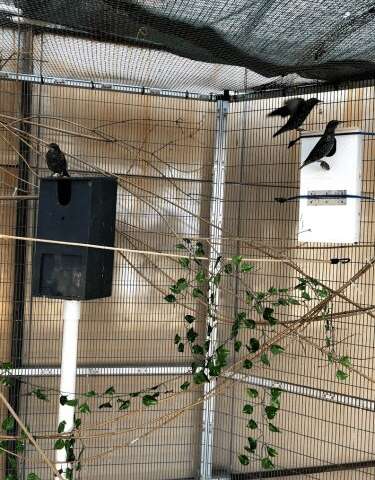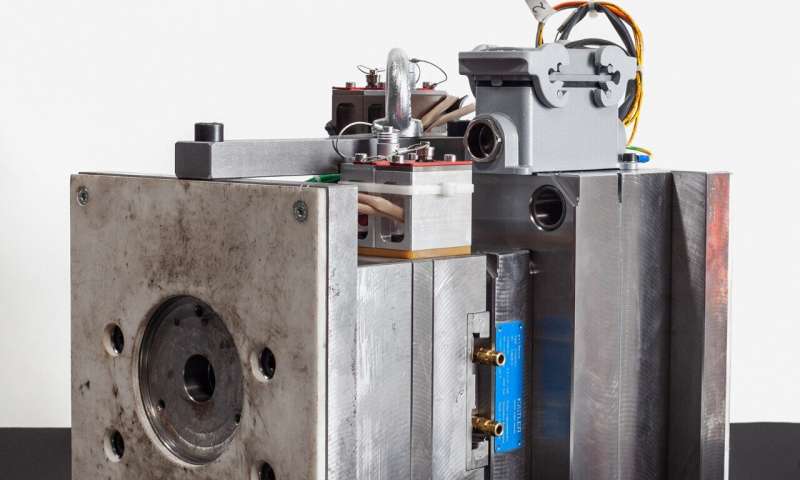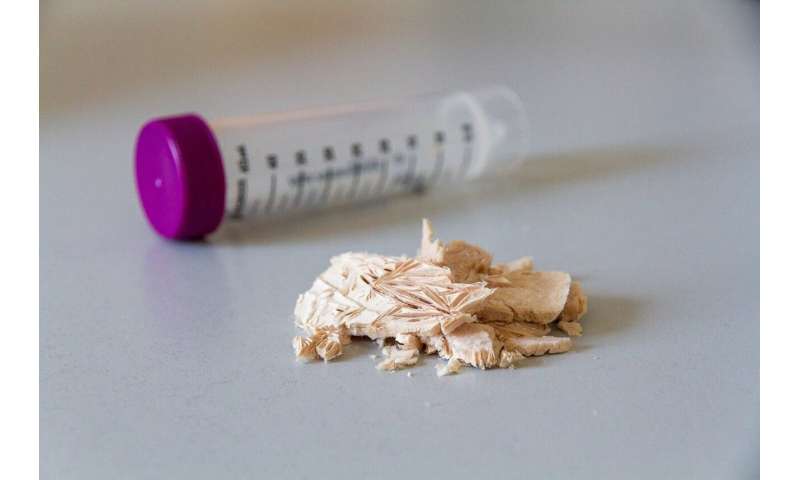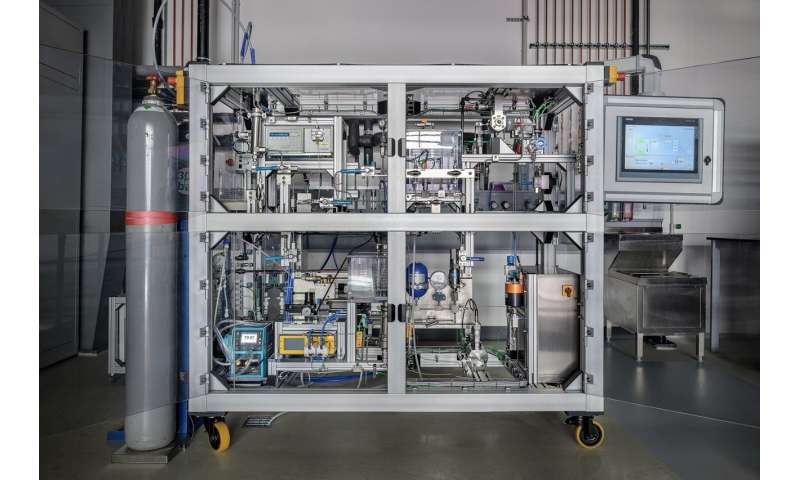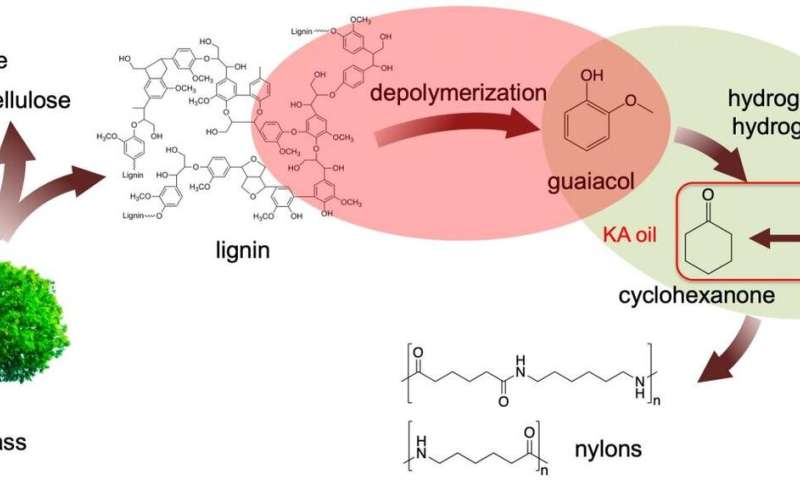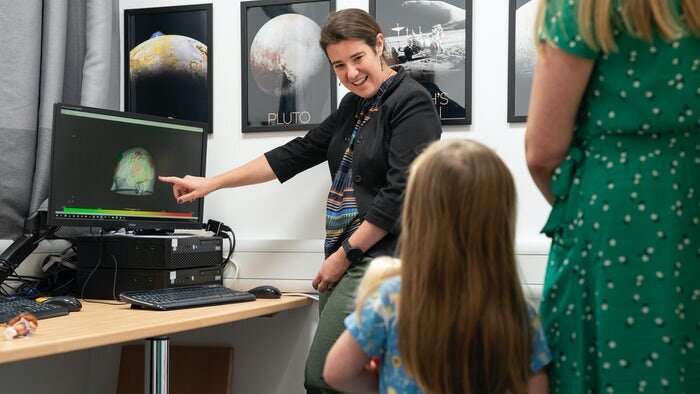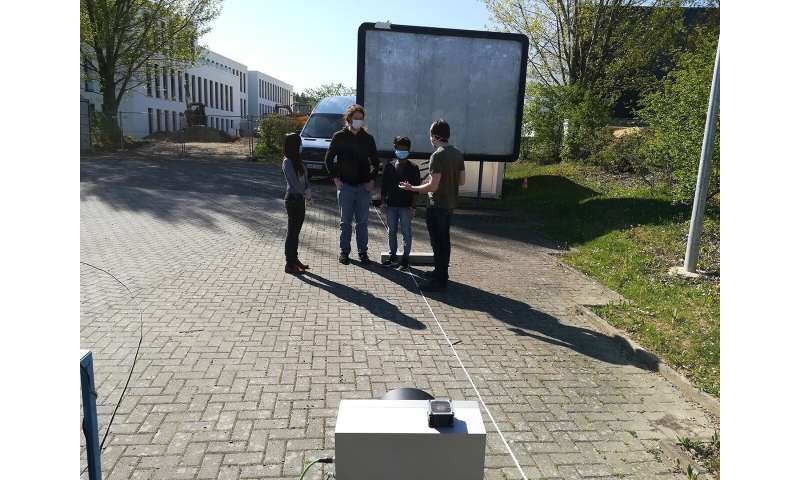by Adriana Brasileiro

Credit: CC0 Public Domain
During a scouting mission to check on coral colonies in inshore Biscayne Bay last year, Caroline Dennison and a few other marine biology graduate students found something astounding: healthy populations of brain corals.
There were no signs of white spots or bleaching and the vivid yellowish brown colors indicated that the corals were untouched by yet another mysterious disease that's ravaging reefs along the Florida coast. Even more extraordinary was that these corals were thriving in shallow and warm water right off the seawall at Bill Baggs Cape Florida State Park, near a bustling seaside metropolis.
"That was pretty amazing because you wouldn't imagine that type of coral living successfully in a foot of water, at that location, considering all the issues affecting reefs in the area," said Dennison, a coral researcher at the University of Miami Rosenstiel School of Marine and Atmospheric Science. "It was just astonishing, I couldn't believe it."
What's protecting these corals? The discovery has opened up a world of research possibilities on what's killing Florida reefs and the water quality problems making it harder for corals to survive in troubled Biscayne Bay.
Dennison is hoping the thriving colonies will shed some light on a myriad of threats to corals: from the impact of rising temperatures and nutrient pollution on reefs to the relationship between corals and the algae that live within them. Findings could also help scientists develop new coral restoration strategies to replenish this key natural protection infrastructure for coastlines against erosion and storms.
The surprisingly good shape of the nearshore corals also highlighted Biscayne Bay's diverse ecosystem, which has pockets of healthy habitats. Not far from these corals, or an artificial reef right next to Port Miami, is the Coral City Camera, which livestreams a constant parade of colorful fish, manatees and sharks near a channel used by huge cruise ships.
Those areas with abundant marine life aren't far from where a massive fish kill happened in August.
The sight of thousands of fish carcasses floating in the northern part of the bay and the algae blooms that followed alarmed residents and triggered a reckoning over critical issues plaguing Miami-Dade's treasured turquoise waters: contamination from crumbling sewage pipes and failing septic tanks, stormwater runoff and a seagrass die-off that's drastically reducing the bay's ability to handle pollution and regenerate.
The Bay is very sensitive to nutrient pollution because historically it didn't have that much phosphorus and nitrogen going into its waters. The Everglades ecosystem filtered these nutrients before the water flowed to the coast. That means that plants and other bay organisms like corals grew slowly because of the nutrient limitation.
Once development and draining altered the flow of the Everglades and population growth led to a jump in nutrient pollution flowing to Florida's coasts, life began to change in Biscayne Bay: slow-growing turtle grass, for example, with its long and broad blades, was replaced by microalgae which grows faster. The bay has lost over 20 square miles of seagrass over the past decade.
"If things grow faster they are competitively dominant; what we've seen over the past decades is a change in species composition from slow-growing things to fast-growing things and now in the northern part of the bay we've gone over the edge," said Jim Fourqurean, a professor of biology and director of the Center for Coastal Oceans Research at Florida International University.
Slower-growing corals like the brain species, which used to be common over the Florida reef tract, have also suffered because of the apparent shift in the bay to a nutrient-rich system, he said during a virtual town hall organized by Commissioner Daniella Levine Cava earlier this week.
"We just gotta stop doing that, we have to stop putting nutrients into the bay so we can return to the system that we used to have," Fourqurean added.
To be sure, nutrient pollution is just one stress factor affecting Florida's coral reefs. A disease that was first observed in 2014 off Virginia Key has been destroying the soft tissue of many stony coral species, killing them within months of becoming infected. Colonies in the U.S. Virgin Islands, the Bahamas, Puerto Rico and as far as Mexico have been affected, and the disease has advanced along the Florida Keys. The causal agent is still unknown.
Brain corals are particularly vulnerable, and that's why Dennison was so ecstatic to find vigorous colonies just steps away from the hiking trail and fishing docks on the seawall at Bill Baggs park.
Water circulation patterns and big tidal variations are some of the environmental factors at play in the area, which led her to wonder if the colonies were ever exposed to what's causing the disease long enough or at high enough concentrations to become infected. Water temperatures in those shallow areas are also 2 to 3 degrees Celsius higher than in offshore reefs, which may have boosted the corals' resilience, she said.
"It also could do with turbidity, or sedimentation. Water quality factors change a lot when you come in from offshore Miami-Dade reefs into these indoor locations, so it could be any number of these environmental factors, either working alone or working together."
And then there's the complex relationship between the corals and their symbiotic algae. This could well be a disease of the algae, and how that symbiosis affects the hosts' immune systems, said UM Rosenstiel School Professor Andrew Baker.
"They seem to be less susceptible to the disease but it's still early days in our research; there are several hypotheses," he said.
One could be that the algae inside the coral are actually the targets of the disease, and when they become infected, "it causes the coral to freak out," Baker said. The symbiosis with corals is so tight that the algae actually live inside the cells of their hosts.
But it could also be that certain types of algae under certain conditions trigger vulnerabilities in the corals, he said. Answers to these questions will be hugely valuable for coral restoration efforts, which have taken on a heightened sense of urgency because of the fast-spreading disease.
"At the rate things are going, we humans need to help out corals. We need to interfere. And genetic manipulation is one way to strengthen these crucial species so they have a chance of surviving what's coming and what's already here," said Liv Williamson, a coral researcher at the Rosenstiel School.
This year, for the first time, UM researchers including Williamson watched the spawning of staghorn corals that had been raised in a lab and transplanted to a restoration reef off Key Biscayne. The corals released their eggs and sperm - gametes as those are collectively called - into the water where they fertilized and made little baby coral larvae in early August. The babies then settled on the reef and formed little new polyps with mouths and tentacles. And that's how they build brand new colonies.
Dennison also checked on her naturally resilient nearshore Biscayne Bay corals during the latest spawning event. Every evening during a whole week in September, she went diving with other researchers in the shallow waters of the bay looking for gametes. With the help of dive lights and equipped with nets and large syringes to collect specimens, small groups of researchers combed the area just off the seawall for hours each night, but no sign of coral sex, she said.
"We may have missed the window this time but we'll be watching these guys very closely," she said. "Finding them really gave us hope that they can teach us something about restoration and continue to help us answer questions about the disease outbreak and water quality issues."
Explore further Lab-grown and replanted corals to spawn in the Florida Keys
©2020 Miami Herald
Distributed by Tribune Content Agency, LLC.
During a scouting mission to check on coral colonies in inshore Biscayne Bay last year, Caroline Dennison and a few other marine biology graduate students found something astounding: healthy populations of brain corals.
There were no signs of white spots or bleaching and the vivid yellowish brown colors indicated that the corals were untouched by yet another mysterious disease that's ravaging reefs along the Florida coast. Even more extraordinary was that these corals were thriving in shallow and warm water right off the seawall at Bill Baggs Cape Florida State Park, near a bustling seaside metropolis.
"That was pretty amazing because you wouldn't imagine that type of coral living successfully in a foot of water, at that location, considering all the issues affecting reefs in the area," said Dennison, a coral researcher at the University of Miami Rosenstiel School of Marine and Atmospheric Science. "It was just astonishing, I couldn't believe it."
What's protecting these corals? The discovery has opened up a world of research possibilities on what's killing Florida reefs and the water quality problems making it harder for corals to survive in troubled Biscayne Bay.
Dennison is hoping the thriving colonies will shed some light on a myriad of threats to corals: from the impact of rising temperatures and nutrient pollution on reefs to the relationship between corals and the algae that live within them. Findings could also help scientists develop new coral restoration strategies to replenish this key natural protection infrastructure for coastlines against erosion and storms.
The surprisingly good shape of the nearshore corals also highlighted Biscayne Bay's diverse ecosystem, which has pockets of healthy habitats. Not far from these corals, or an artificial reef right next to Port Miami, is the Coral City Camera, which livestreams a constant parade of colorful fish, manatees and sharks near a channel used by huge cruise ships.
Those areas with abundant marine life aren't far from where a massive fish kill happened in August.
The sight of thousands of fish carcasses floating in the northern part of the bay and the algae blooms that followed alarmed residents and triggered a reckoning over critical issues plaguing Miami-Dade's treasured turquoise waters: contamination from crumbling sewage pipes and failing septic tanks, stormwater runoff and a seagrass die-off that's drastically reducing the bay's ability to handle pollution and regenerate.
The Bay is very sensitive to nutrient pollution because historically it didn't have that much phosphorus and nitrogen going into its waters. The Everglades ecosystem filtered these nutrients before the water flowed to the coast. That means that plants and other bay organisms like corals grew slowly because of the nutrient limitation.
Once development and draining altered the flow of the Everglades and population growth led to a jump in nutrient pollution flowing to Florida's coasts, life began to change in Biscayne Bay: slow-growing turtle grass, for example, with its long and broad blades, was replaced by microalgae which grows faster. The bay has lost over 20 square miles of seagrass over the past decade.
"If things grow faster they are competitively dominant; what we've seen over the past decades is a change in species composition from slow-growing things to fast-growing things and now in the northern part of the bay we've gone over the edge," said Jim Fourqurean, a professor of biology and director of the Center for Coastal Oceans Research at Florida International University.
Slower-growing corals like the brain species, which used to be common over the Florida reef tract, have also suffered because of the apparent shift in the bay to a nutrient-rich system, he said during a virtual town hall organized by Commissioner Daniella Levine Cava earlier this week.
"We just gotta stop doing that, we have to stop putting nutrients into the bay so we can return to the system that we used to have," Fourqurean added.
To be sure, nutrient pollution is just one stress factor affecting Florida's coral reefs. A disease that was first observed in 2014 off Virginia Key has been destroying the soft tissue of many stony coral species, killing them within months of becoming infected. Colonies in the U.S. Virgin Islands, the Bahamas, Puerto Rico and as far as Mexico have been affected, and the disease has advanced along the Florida Keys. The causal agent is still unknown.
Brain corals are particularly vulnerable, and that's why Dennison was so ecstatic to find vigorous colonies just steps away from the hiking trail and fishing docks on the seawall at Bill Baggs park.
Water circulation patterns and big tidal variations are some of the environmental factors at play in the area, which led her to wonder if the colonies were ever exposed to what's causing the disease long enough or at high enough concentrations to become infected. Water temperatures in those shallow areas are also 2 to 3 degrees Celsius higher than in offshore reefs, which may have boosted the corals' resilience, she said.
"It also could do with turbidity, or sedimentation. Water quality factors change a lot when you come in from offshore Miami-Dade reefs into these indoor locations, so it could be any number of these environmental factors, either working alone or working together."
And then there's the complex relationship between the corals and their symbiotic algae. This could well be a disease of the algae, and how that symbiosis affects the hosts' immune systems, said UM Rosenstiel School Professor Andrew Baker.
"They seem to be less susceptible to the disease but it's still early days in our research; there are several hypotheses," he said.
One could be that the algae inside the coral are actually the targets of the disease, and when they become infected, "it causes the coral to freak out," Baker said. The symbiosis with corals is so tight that the algae actually live inside the cells of their hosts.
But it could also be that certain types of algae under certain conditions trigger vulnerabilities in the corals, he said. Answers to these questions will be hugely valuable for coral restoration efforts, which have taken on a heightened sense of urgency because of the fast-spreading disease.
"At the rate things are going, we humans need to help out corals. We need to interfere. And genetic manipulation is one way to strengthen these crucial species so they have a chance of surviving what's coming and what's already here," said Liv Williamson, a coral researcher at the Rosenstiel School.
This year, for the first time, UM researchers including Williamson watched the spawning of staghorn corals that had been raised in a lab and transplanted to a restoration reef off Key Biscayne. The corals released their eggs and sperm - gametes as those are collectively called - into the water where they fertilized and made little baby coral larvae in early August. The babies then settled on the reef and formed little new polyps with mouths and tentacles. And that's how they build brand new colonies.
Dennison also checked on her naturally resilient nearshore Biscayne Bay corals during the latest spawning event. Every evening during a whole week in September, she went diving with other researchers in the shallow waters of the bay looking for gametes. With the help of dive lights and equipped with nets and large syringes to collect specimens, small groups of researchers combed the area just off the seawall for hours each night, but no sign of coral sex, she said.
"We may have missed the window this time but we'll be watching these guys very closely," she said. "Finding them really gave us hope that they can teach us something about restoration and continue to help us answer questions about the disease outbreak and water quality issues."
Explore further Lab-grown and replanted corals to spawn in the Florida Keys
©2020 Miami Herald
Distributed by Tribune Content Agency, LLC.
